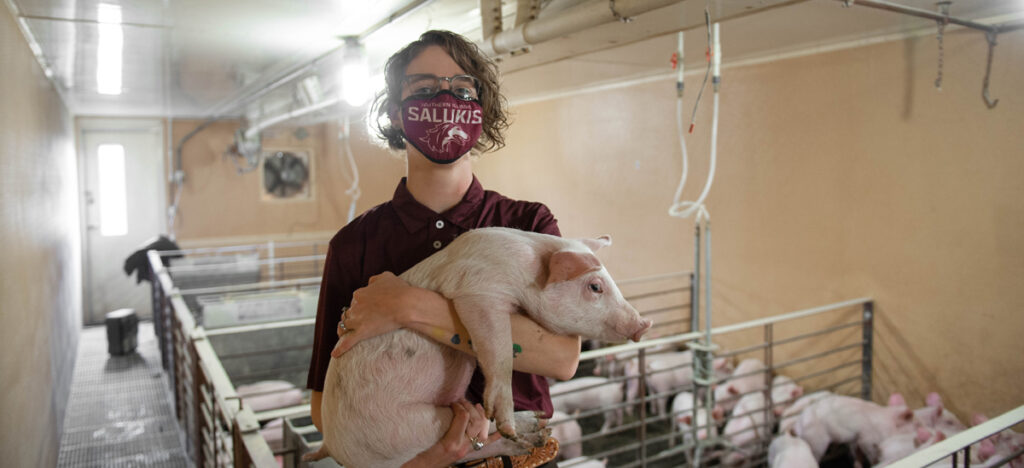
Kathryn Prus, the new manager of Southern Illinois University Carbondale’s Swine Center, quickly embraced a demanding part of her job last summer: spending 24/7 around pigs, needing a blanket for herself, while the expanding sounder of pigs bore offspring over a span of a few days.
“I slept with the baby pigs at the farrowing barn,” Prus said. “The sow has to be checked every 30 minutes, and it’s amazing how fast there can be complications. I eventually got to the point where I just knew I wasn’t going to sleep.”
Prus’ arrival is part of SIU’s commitment to improvements on raising and researching swine. Pigs are big business throughout the state as a food source, but they’re also valued for much more.
Pigs and humans, both inquisitive, social mammals, share various anatomic and physiologic traits, such as organ placement (and often size and function), skin similarities and some disease progression.
A pig weighing around 130 pounds, for example, will resemble a human body in many ways. Medical research using pigs to understanding humans has been done for nearly 40 years, and pigs are a translational research model. This means that if something works in a pig, it has a higher possibility of working in a human. Pigs have been used for heart valve transplants and tested for medical devices.
In addition, some of the protein aberrations that pigs share with humans are associated with obesity, diabetes, dyslexia, Parkinson’s disease and Alzheimer’s disease. This understanding of the genetic origins of modern pigs is important for their breeding and to find new ways to address old and emerging diseases.
“Pigs are very similar to people in other ways — like a 3-year-old human child,” Prus said. “Very intelligent. If they can get their noses on it, they’ll figure it out. There is a lot of hands-on research for students here now. And they’re also great for any student to study, because they require a lot of discipline and critical thinking. It’s all about paying attention. It’s all about observation. What you see, smell, hear and even sometimes just the taste of the air — the key to farming pigs is to pay attention to all of the small details, and the big picture, at the same time.”
Pork is a big commodity in Illinois
In case you wondered — yes, Prus eats pork. She appreciates a good fried pork chop.
Her first goal raising about 140 young pigs is to get custom packing started. That means offering a pig to the public or other SIU entities for consumption. The ongoing goal is produce meat that can be sold in local markets.
Illinois is the fourth largest pork-producing state in the U.S. There are more than 2,000 farmers in the state, including The Maschhoffs. The Carlyle-based company estimates that its pork feeds approximately 15 million per year. That makes it one of the top 10 producers in the world, with a family that has deep roots at SIU.
The Maschhoffs recently donated feed to help University Farms nourish its newest residents.
“SIU and the College of Agricultural, Life, and Physical Sciences has played an important role in both our personal and business growth,” said Ken Maschhoff, an SIU graduate and chairman of the board of the five-generation family farm. “We want to support the program that gave us a start, and we hope it pays forward to others.”
Longtime interest in pigs

Prus became interested in agriculture in ninth grade, when she happened to be randomly assigned to a course. She quickly cherished the meticulous, obsessively curious traits required to thrive. She’s driven to teach students about the value of pigs.
Her path at SIU started by selling four animals to get 10 new breeders, and quickly raising a new generation. The ongoing plan is work on the farrow house, replacing old crates and building toward a more modern and industry-relevant setting.
At the Swine Center’s heart, though, Prus is in Carbondale to cater to the animals.
“When I interviewed, all I saw at SIU was potential for growth and success,” Prus said. “There’s so much for students to learn about animal production and the value of pigs. And I promise we will raise some really happy critters.”






